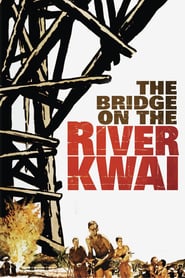
During the 1940’s, director David Lean hewed his skills directing quiet personal stories of ordinary people (Brief Encounter) and cinematic interpretations of literal classics (Great Expectations and Oliver Twist). In these fine films he developed a fine eye for characterization and period detail. In the following two decades, Lean became absorbed in bringing large spectacular stories new life on the giant screen. These were Epics of the type only Hollywood could conceive and Lean became the elite oeuvre of the epic film. Four of the greatest epics made in Hollywood were penned by him.
The first of these epics was the glorious war film, “The Bridge on the River Kwai”. The movie is a fictional account of the building of a bridge in Burma by the Japanese army and by use of POW slave labor. Filmed on location in Sri Lanka and sparing no cost, the producers of this movie built an actual bridge only to be destroyed by them for the movies finale. In making the movie, Lean became fascinated in all that goes into creating a gigantic production in order to tell a story. What truly allowed his vision to bear fruition was the fact that he kept true to his origins and gave deep human characterizations to the protagonists in the film while using his acute eye for detail in getting the settings just right.
The story follows the plight of British POWs in a Japanese internment camp run by the strict and fearful Saito (The great silent film actor Sessue Hayakawa). The leading officer of the POWs is the regimental, ultra-traditional and brave Colonel Nicholson (Alec Guinness who once again proves that he was one the great actors of cinema). Saito is ordered to build the bridge of the film’s title and has a strict deadline for completion. His thought process is that all the POWs must work to this end under the fear of death. Nicholson points out to him the Geneva Convention rule that states Officer POWs will not be made to perform hard labor. I found it a bit ironic that this fairly harmless rule in the convention is emphasized as being unmoving during a time when the Nazis were slaughtering peoples by the thousands and the Japanese were starving their prisoners to death. Nicholson’s stubborn demand to adhere to this protocol hints at what may have been possible if more people stood up to war atrocities during the war.
The first half of the film deals in this battle of wills between Saito and Nicholson. The result is a fascinating and tense filled prison drama. The determination against pain of torture serves to build Nicholson as a hero and martyr for his men. Watching Guinness as Nicholson exiting the oven he was placed in and standing firm is film magic and Guinness’s performance during this scene is heart wrenching and spectacular. Saito for his part also fears for his own life, knowing that failure to build the bridge will force him to commit Hari Kari (Suicide by the sword).
What brings this film above being just a great prison drama is the way its 2nd half develops. Nicholson having won his battle with Saito and after winning the utter respect of his men, becomes a collaborator with the Japanese and works to improve and help the building of the bridge. At the same time as the bridge is being built an escaped American prisoner (William Holden), is planning its destruction alongside a team of commandos. The race to build and at the same time destroy the bridge between supposed allies, is the paradox that twists this epic to its spectacular finish.
The more I watch this movie, and it is the type of film that I never tire of viewing, the more it seems to me that Nicholson became insane sometime during the period he was being tortured. What emerged was a man who had no real awareness of reality and lived off of pure obsessive drive.
Throughout it all we are given wide expansive scenes of the Jungle and the prison camp.
Throughout everything we are treated to an emotional music score that peaks with the unforgettable whistle march sung by the prisoners (The Colonel Bogey March).
The ending pits British and Japanese against British and American, Sane against insane, war and death against Tradition and life. Lean films the ending with spectacular suspense and power, intercutting all these scenes with superb editing that flow through each of the protagonists view point. Many die and the last uttered words of madness are more than fitting for a war movie.
Most War movies are either patriotic and pro war or socially conscience and antiwar. This is one of the few that is neither. Instead it deals in human nature, battles of will and courage without actually taking sides.
It has spectacular scenes of bridge building, torture and battle while staying true to the complex nature of its characters. It is a grand epic and truly one of the greatest movies of war ever made.

